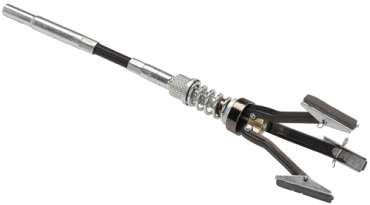The MGA With An Attitude
Techniques for REBUILDING HYDRAULIC CYLINDERS - HT-205
General procedure for rebuilding any hydraulic cylinder is, disassemble, hone the bore until smooth, clean thoroughly, and reassemble with new seals. A brake hone is very cheap, likely under $10, and may save you LOTS of money in replacement parts.
 Use the hone with a power drill. Squeeze the stones together, insert into the cylinder bore, apply a little fluid for washing away the swarf so the stones don't clog, and spin away. Move the tool up and down the bore as it works to avoid creating annular scratches. Lighter oil is good for faster, more aggressive honing. Penetrating oil, mineral spirits, alcohol, lacquer thinner, or even water - anything thin to wash away the grinding grit and keep the stones clear. Thicker oil is slower but produces a smoother surface finish, good for final honing. Using engine oil will usually produce a suitable surface finish, even with fairly coarse stones. It's a nice trick if you only have one set of stones.
Use the hone with a power drill. Squeeze the stones together, insert into the cylinder bore, apply a little fluid for washing away the swarf so the stones don't clog, and spin away. Move the tool up and down the bore as it works to avoid creating annular scratches. Lighter oil is good for faster, more aggressive honing. Penetrating oil, mineral spirits, alcohol, lacquer thinner, or even water - anything thin to wash away the grinding grit and keep the stones clear. Thicker oil is slower but produces a smoother surface finish, good for final honing. Using engine oil will usually produce a suitable surface finish, even with fairly coarse stones. It's a nice trick if you only have one set of stones.
If you have deep pit marks you may not be able to hone them out. The hone does not remove much material. For deep scratches and notable pit marks you may need to have it bored out and sleeved. Most slave cylinders are cheap enough to buy new. Some master cylinders are expensive enough to merit the cost of boring and sleeving.
Soak the parts with brake fluid before assembly. For the master cylinder, be sure the seals seat completely into the grooves on the pistons. Twist them around and around until they settle down if necessary.
At 04:05 PM 1/8/06, Steve,Berg wrote:
>".... master cylinder pistons are sticking in the bores after honing."
After assembly, press the piston full in manually, and it should pop back out from spring return force only. If not, apply air pressure on the fluid port to bring the piston back. Repeat as many times as necessary until it loosens up and returns freely by spring force only. This may well require 20 cycles of more, but be patient, it will eventually loosen up enough to return freely every time. This depends mostly on surface finish of the bore after honing.
If the piston sticks only at the far end of travel, this must be a result of a variation in the bore, which can be fixed by honing. If the piston sticks equally all the way down the bore, then you may have a problem with fitting of the seals. The seals may not be fully seated in their nesting grooves on the piston. It is quite unlikely that the seals are oversize (but may be possible to have defective seals).
In normal operation the piston does not travel all the way to the back end of the bore. Much of the bore will wear a little from rubbing contact of the seals, while the deepest end of the bore will have little of no wear. This makes a slight difference in diameter where the bore is a bit smaller at the deep end. In most cases the piston slides freely for most of the travel and only sticks right at the end of travel. There may be a bit of corrosion in the part of the bore which was not normally touched by the seals. It is important to hone the bore before installing new seals to remove any small wear marks and any possible roughness in the bottom of the bore.
|
 Use the hone with a power drill. Squeeze the stones together, insert into the cylinder bore, apply a little fluid for washing away the swarf so the stones don't clog, and spin away. Move the tool up and down the bore as it works to avoid creating annular scratches. Lighter oil is good for faster, more aggressive honing. Penetrating oil, mineral spirits, alcohol, lacquer thinner, or even water - anything thin to wash away the grinding grit and keep the stones clear. Thicker oil is slower but produces a smoother surface finish, good for final honing. Using engine oil will usually produce a suitable surface finish, even with fairly coarse stones. It's a nice trick if you only have one set of stones.
Use the hone with a power drill. Squeeze the stones together, insert into the cylinder bore, apply a little fluid for washing away the swarf so the stones don't clog, and spin away. Move the tool up and down the bore as it works to avoid creating annular scratches. Lighter oil is good for faster, more aggressive honing. Penetrating oil, mineral spirits, alcohol, lacquer thinner, or even water - anything thin to wash away the grinding grit and keep the stones clear. Thicker oil is slower but produces a smoother surface finish, good for final honing. Using engine oil will usually produce a suitable surface finish, even with fairly coarse stones. It's a nice trick if you only have one set of stones.